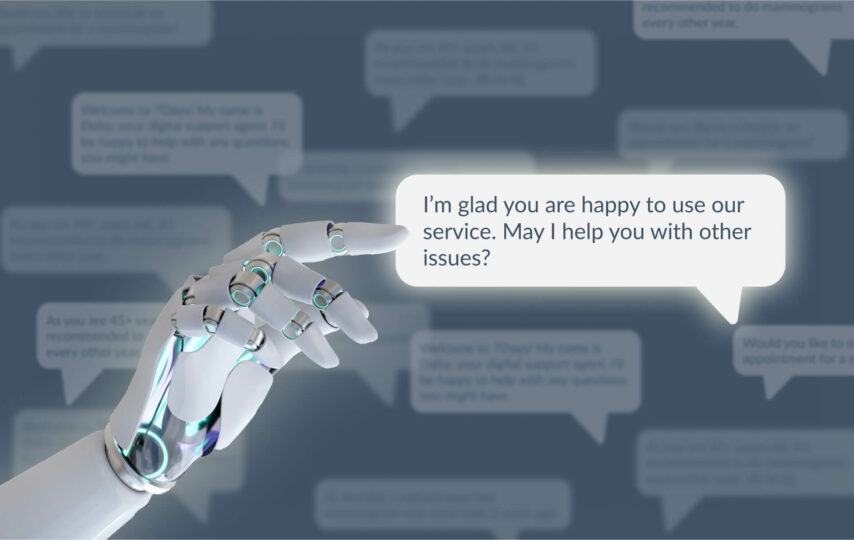GPT-3 and ChatGPT API Integration are all over the news. With the potential to create human-like content, GPT-3 acts as a game-changing tool to reinvent how we think about customer service. It can help automate customer services and support, allowing businesses to increase their sales and cut down unnecessary costs, which can help to boost the total revenue.
This post intends to highlight the use of GPT3-powered Chatbots to transform your customer service.
Key Differences between ChatGPT and GPT-3
ChatGPT (Chat Generative Pre-Trained Transformer) is a machine-learning-based model that can generate human-like responses to queries and concerns. It is based on the GPT-3 model developed by OpenAI. On the other hand, GPT-3 (Generative Pretrained Transformer 3) is an artificial intelligence system that uses Natural Language Processing (NLP) to produce human-like text. It is the third generation of the transformer model created back in 2017. GPT-3 gained immense popularity as one of the most capable and powerful AI systems ever built.
Both ChatGPT and GPT-3 can produce human-like content, but they aren’t the same. There are some key differences between them.
GPT-3 has an open API that helps you integrate internal processes and systems to provide your company-specific information to a chatbot. On the other hand, ChatGPT has no open API so you can’t access its language model or integrate your data. In addition, ChatGPT is based on a smaller text model and 117 million parameters. On the flip side, GPT-3 is developed with vast text data of 45 TB and a capacity of 175 billion parameters. Hence, GPT-3 is more suitable for automating a wide range of tasks.
Below are some noteworthy differences between ChatGPT and GPT-3
| ChatGPT | GPT-3 |
| No open API. You cannot integrate your own data. | Has an open API. You can easily integrate your data. |
| Has a smaller text model with 117 million parameters | Has a vast text model with 175 billion parameters. |
| Designed mainly for chatbot applications. | Has a much larger scope, including language translations and content creation. |
| Readily available to use | Requires additional setup |
Advantages of Using GPT3-based Chatbot in Customer Services
If used correctly, there are various benefits of using GPT3 in customer services:
- Human-like conversations
GPT-3 uses deep learning capabilities to deliver human-like responses, making the conversation easier. A GPT3-powered chatbot will make your customers feel as if they are interacting with an actual human being, and not just a chat robot. It helps increase the customer engagement and satisfaction rate.
- 24×7 availability
A GPT3-supported chatbot is available 24×7. It is always ready to serve your customers, no matter if it’s day or night. This is particularly difficult to achieve with human customer service, which requires hiring more workforce for night shifts and managing them. If companies don’t resolve queries at the right time, the customers might switch to a different company (likely a competitor) that offers better customer service. A GPT-3 chatbot offers great help here. It offers customer service round the clock. So, your customers get all the answers at the right time which increases customer loyalty.
- Faster response time
Customers now look for more meaningful and faster responses. Longer waiting times eventually lead to a low customer satisfaction rate. A GPT-based chatbot delivers instant responses which brings down the waiting time to a couple of seconds. It isn’t feasible with human customer service where your support team has hundreds of requests stacked up from potential clients. Businesses can lose this pile by integrating GPT3 API into their existing apps. It will help you build a long-lasting relationship with your customers.
- Omnichannel support
A client may use multiple channels to interact with a brand. With the right GPT-3 API integration, you can be exactly where your customer needs you. The GPT3-based chatbots can handle several tasks like drafting email campaigns, articles, essays, blogs, and social media posts. Also, these AI-based chatbots can generate unique responses based on the previous messages in a conversation. Businesses can use GPT-3 chatbots to say thank you, send a gentle reminder of an upcoming event, and share a social media post to drive customer engagement.
- Cost efficiency
Cost efficiency is another advantage of using GPT-3 chatbots for customer support. Proper implementation of GPT-3 can help businesses automate their everyday tasks, from answering FAQs and scheduling appointments to creating & posting emails and sharing social media posts. It allows your customer support team to focus on more complex queries that require human intervention. Also, GPT-3 API integration is comparatively more affordable than hiring more employees for general query load or investing in human operators for repetitive tasks. Compared to humans, GPT-3 chatbots can engage with unlimited people at once and drive up sales.
Companies will need a few employees to overlook these activities, but GPT-3 chatbots can lead to significant cost savings and faster customer service.
- Multilingual support without the need for a translator
One of the biggest advantages of using a GPT3-powered chatbot for customer service is its multilingual support. Businesses with an international audience base can fulfill customer requirements in their native language. It not only helps in easy conversations but makes a business more approachable to a customer.
- Increased sales
By being available 24×7 for customers, GPT-3 chatbots can bring more sales for your business. It can provide relevant information to browsing consumers, answer customer queries, and send reminders to expedite the buying decision. Businesses can market their newly offered services, offer personalized recommendations, and help consumers find exactly what they are looking for. When this happens the right way, customers are more likely to buy the product.
Pitfalls of Using GPT3-based Chatbot in Customer Services
While GPT-3 can help you with customer service, it isn’t all rainbows and unicorns. A GPT3-powered chatbot may have everything, but it’s still not human. Hence, there are some challenges related to GPT-3 chatbots, and you should know about them before integrating the API to your platform/solution.
GPT-3 chatbots can make human-like conversations, but they lack human touch. It means:
- A GPT-3 chatbot can provide outdated or wrong information.
- It may not understand or be able to deal with sarcasm.
- It might lose the context of a conversation if the subject gets changed too quickly.
- A chatbot cannot completely empathize with the customers.
- Although GPT-3 significantly decreases the employee training cost, it requires the correct human guidance to solve certain problems.
How Can You Successfully Integrate GPT-3 into Your Customer Service Flow?
To successfully integrate GPT-3 into your existing customer service flow, you will need:
- An API for ChatGPT
- A suitable programming language like PHP, Javascript, Python
- professional programmers who can deploy these languages, libraries, and frameworks
Once you have decided on these, you can move on to the next steps.
- Get Access to GPT-3 API
First, sign up for OpenAPI’s API and apply for access to GPT-3. You can register with OpenAI or one of their partners. Once your request gets approved, you will receive an API key to integrate GPT-3 into your chatbot.
- Choose a platform
Choose a GPT3-supported platform that’s compatible with your development stack and offers all the required features. There are various options, including OpenAI, EleutherAI, and Hugging Face.
- Define the scope of your chatbot
Specify the objective and scope of your chatbot. It includes determining the use cases, conversation flow, tone of voice, and types of questions the chatbot will handle. This is the step where you decide the capabilities of your chatbot for customer service, i.e., will it handle inquiries, provide recommendations, or schedule appointments?
- Collect training data
To create a more efficient chatbot, you should do text-based interactions and obtain its dataset. This can be customer support tickets, chat logs, and other relevant sources.
- Train the GPT-3 model
Once you have the realistic chat-oriented data, compile it to train your chatbot more efficiently. Without this, the GPT-3 model will not completely understand the context of your chatbot’s interactions. As a result, it won’t solve the inquiries or answer the questions without human intervention. To make sure your GPT-3 chatbot offers accurate customer support, you should fine-tune and train the model through iterations.
- Design the chatbot interface
Build the interface of your chatbot using a compatible platform like Microsoft Bot Framework or Dialogflow.
- Integrate GPT-3 API
Use the GPT-3 API to integrate the GPT-3 model into your chatbot. When successfully integrated, your chatbot will make human-like conversations.
- Test and refine
Thoroughly test your chatbot with real users and see how it performs. Based on the feedback, refine your chatbot to deliver the best possible customer service.
FAQs related to GPT-3
How Are GPT3-powered Chatbots Different from Traditional Chatbots?
A Traditional Chatbot, also known as a Rule-based Chatbot follows pre-set rules to interact with the audience and achieve certain objectives. Some common examples include talking to an agent or signing up for a demo. Without AI, traditional chatbots can only respond to pre-parameterized keywords and cannot have natural conversations. As a result, smaller organizations with fewer customers use traditional chatbots, where an array of pre-defined rules can help answer frequently asked questions.
On the other hand, a GPT3-based chatbot can mimic human conversations and help gather meaningful data for your business. Also, GPT-3 is based on massive text data and parameters to serve multiple purposes. Therefore, even larger companies can automate repetitive processes and frequently asked questions for better customer satisfaction.
Is GPT-3 free to use?
Yes, GPT-3 is free to use. You can use your email to create an account on OpenAI, and then access GPT-3 via OpenAI Playground.
How can you use GPT-3 for customer service?
You can integrate GPT-3 into your existing software to automate your customer service. You may also build a new chatbot solution and integrate GPT-3 into it.
Are GPT-3 chatbots beneficial for customer service?
Yes, GPT3-powered chatbots can offer 24×7 meaningful support and faster responses, which makes your business more appealing to customers.
Endnote
Implementing GPT-3 to your customer service flow offers various advantages. First, customers get faster solutions at the right time. Second, companies get a chance of increased sales, higher profits, and fair cost-cutting while serving their customers more effectively. Therefore, it’s a win-win situation. Most importantly, you go along with new technology and reap all the benefits and grow your business.
For the best results, we recommend starting with the right technology stack and hiring a team of developers with the capability to integrate GPT-3 API to develop a custom chatbot for your business.








